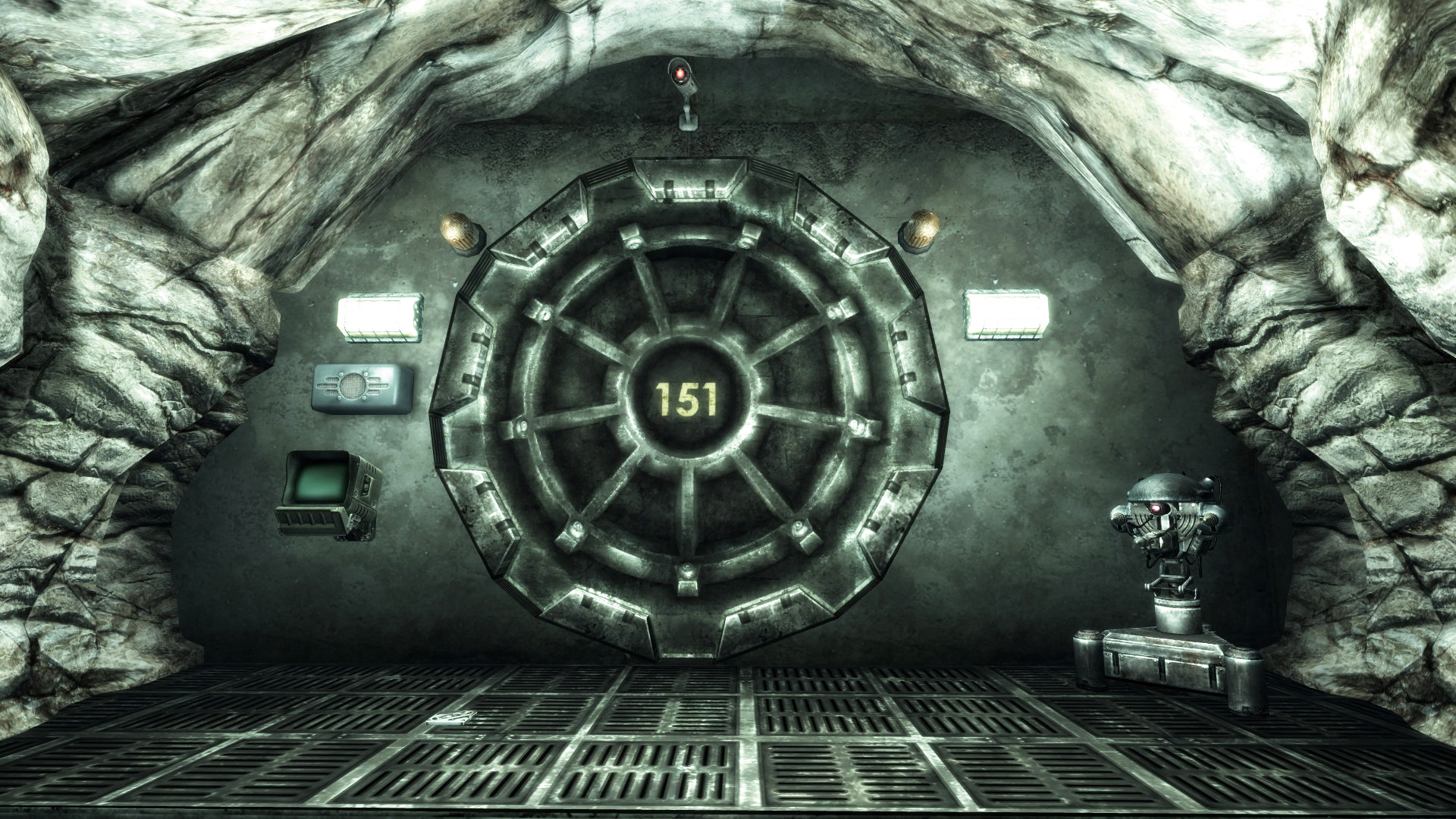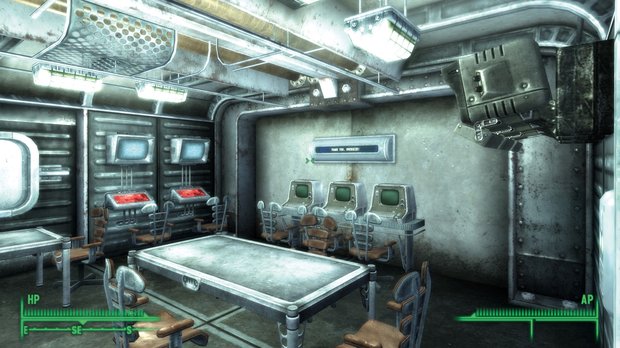Unearthing the terrible secret of Fallout's vaults
Beside a section of collapsed highway in Fallout 3 is a 200-year-old billboard with a family on it. The father smokes a pipe, the mother is in pearls and the son is dressed up in a jacket and tie. All three are smiling. The paint is peeling, but when you get closer you see that this family is part of a long procession filing towards a gleaming metal hole in the side of a mountain. Mushroom clouds billow in the distance. Above them a faded banner exclaims, “Vault secure!”

Ever since the original Vault Dweller was dispatched from Vault 13 to replace a broken water chip, the Vault Network and its inhabitants have been a defining feature of Fallout’s pitiless Wasteland. They’re sometimes starting areas, providing Fallout and Fallout 3 with an immediate contrast between the comparatively cushy surroundings of a nuclear shelter and the filth and barbarism of the world outside. More commonly, the Vaults are questing locations or dungeons full of mediocre loot. But unless you’re grunting your way through one of the games’ famed low-Intelligence playthroughs, you’ll quickly discover that most vaults are a broken promise of sanctuary, their rusted chambers buzzing not with human life, but with giant insects skittering over skeletons in blue jumpsuits, or crawling with mutants.
In the murky world of Fallout’s expansive canon, the Vault Network begins life as the US’s government-funded Project Safehouse in 2054. The UK and the rest of the European Commonwealth are at war over oil in the Middle East, while the US and China are ploughing what resources they have left into both conventional and unconventional weaponry for a face off that seems almost inevitable. A plague has already killed tens of thousands in the US, while a terrorist nuclear weapon has destroyed Tel Aviv. The twin threats of nuclear world war and plague thus lead to Project Safehouse and the construction of 122 Vaults to shield a fraction of the population if the worst should occur, which it eventually does.
Before the Great War, as the resulting disaster was christened, the Vaults were like modern-day battleships or fighter jets: technological marvels whose grim purpose was lost in impressive numbers and statistics. But few ever believed that this technology would be anything more than a marvel. The grinning Vault Boy and the happy families in the posters are symptomatic of a nation refusing to fully embrace a terrifying reality.

Even the Vaults’ own architects shrugged off the idea that full-on nuclear war was a real possibility. Hidden away in a terminal in Vault 0 is a Vault-Tec representative’s missive explaining that due to the “dwindling chance [of] actual nuclear war” its costly backup systems would be replaced with high-class restaurants, piano bars and “two subterranean hunting grounds stocked with rare animals purchased from world-renowned zoos”. It’s a funny, preposterous moment, but also incredibly sad.
Yet the real tragedy of the Vaults is the beguiling mixture of optimism and sadism tied up in their design. You see, there’s a darker purpose to these chambers: most aren’t here to be safe havens, but rather centres for human experimentation on a grand scale. Chemical, biological, social and various other bizarre tests are set in motion for the apparent benefit of the shadowy Enclave. And even in the control vaults, which should be fit for purpose, the estimates of their durability have been drastically overestimated, while the supplies provided are laughably inadequate to face the world outside.
Their inhabitants’ unpreparedness is what makes exploring any of the Vaults so haunting. Inside each, the evidence of what life has been like here is either a stark contrast to the world you’ve wandered in from, or a nightmare made real. Old email accounts preserve petty squabbles between inhabitants. Posters remind citizens of the Vault’s annual cake bake off. And yet those very inhabitants and their descendants often now crawl these corridors as ghouls or mutants, or served a gruesome purpose long ago.
Sign up to the GamesRadar+ Newsletter
Weekly digests, tales from the communities you love, and more

The dwellers in the few successful Vaults by and large feel safe in their ignorance of the outside world. Surely with their agricultural training holodisks and enough goodwill, rebuilding America will be a cinch when the time comes.
When the door finally opens, they wander blinking into the Wasteland’s sun, ready with their bottles of purified water and Garden of Eden Creation Kits to reestablish civilisation. Sometimes, they are eaten by a grisly horror, or get dragged off by super mutants to be dipped into vats of mutagenic goo. The hapless goodwill of the Vault dwellers is underlined by Fallout 2's intro, where the door of Vault 13 rolls away to reveal a squad of power-armoured baddies outside. Silhouetted against the bright lights of the chamber, one of the dwellers waves uncertainly. All are then cut to pieces in a storm of bullets, their deaths reflected in the pitiless yellow eyes of an Enclave soldier.
And this resonates because, for all the factions and conspiracies in which the Vaults are key, you’re among the few with ties to one. Because you know the inner workings of a Vault, squinting in the dim light of a ruined one is all the more harrowing. Almost every Vault you explore is a stark reminder of trust betrayed, of another group of wide-eyed folk sent to their grim deaths. Now only some faded, tragically cheery Wasteland posters remain to identify their last refuges as anything more than creaking, rusting tombs.
Read more from Edge here. Or take advantage of our subscription offers for print and digital editions.
Edge magazine was launched in 1993 with a mission to dig deep into the inner workings of the international videogame industry, quickly building a reputation for next-level analysis, features, interviews and reviews that holds fast nearly 30 years on.



